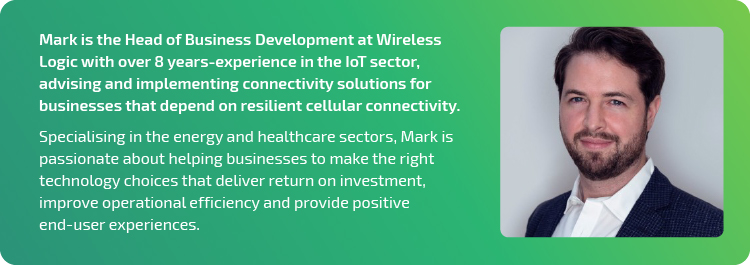The way energy is generated, stored and distributed is changing. Reliance on fossil fuels must diminish and renewable energy sources will take their place. Green energy has to be cost-effective and resilient against risks that could disrupt supply or operations. With the right digital ecosystem in place, enabled by the IoT, energy companies can monitor and manage a transformed energy infrastructure comprising solar and wind farms, smart meters, battery storage, a smart grid and more.

The challenges of energy provision
Since 2021, energy supply and demand has been out of balance, impacted by the war in Ukraine and the end of pandemic restrictions, resulting in a cost of energy crisis and potential gas shortages.
The World Energy Council tracks how national energy systems perform through the World Energy Trilemma Index. This seeks to provide insights into how countries are faring in meeting energy demands equitably and maintaining a balance as the world transitions to decarbonised systems.
The Index measures national energy systems against:
- Energy security – nations must be able to meet existing and future energy demands reliably, and cope with any ‘shocks’ to the system with only minimal supply disruption
- Energy equity – often positioned as affordability, this describes a country’s ability to provide affordable energy for all users
- Environmental sustainability – measures a country’s energy transition to mitigate climate change.
In the 2021 index, the UK ranked joint fourth overall behind Sweden, Switzerland and Denmark and alongside Finland. However, on energy equity it ranked ninth, tenth on environmental sustainability and didn’t feature at all in the top 10 for energy security. This positioning demonstrates that the UK has more to do to match other nations’ progress in striking the right balance within a healthy energy system.
Nations like the UK can bolster their energy security, and take steps to improve energy equity, through ‘home-grown’ energy which mitigates global supply and cost risks by reducing reliance on imports. At the same time, they must continue to strive for sustainability through greenhouse gas emissions targets and reducing energy’s environmental impact.

Gartner® 2021 report, Urgent Action Needed: Energy Markets Are Changing Raster Than Energy Companies states that “oil and gas companies can no longer ignore the global shift to renewable energy sources”. It examines the environmental, economic and technological factors driving industry trends and recommends that oil and gas companies, “adopt a unified portfolio for technology innovation investments that brings together digital innovations for efficiency and agility, as well as energy innovations that create new low-carbon products and solutions.”
Transitioning to IoT-connected energy solutions
Recent innovation in the energy sector demonstrates the strides taken to meet the challenges described in the energy trilemma. Electric vehicles, microgrids, wind turbines, solar farms, hydro power plants, smart meters, energy distribution capabilities and battery storage all form part of energy’s transformation. In parallel to these transformational initiatives, the adoption of technology in the sector, particularly IoT, has also accelerated. Technology is being implemented to aid the effectiveness and management of these new transformational initiatives, ultimately through the transmission of data via cellular IoT. The data that is captured and transmitted provides energy companies with the following capabilities:
- Monitoring – of environment and/or device conditions
- Action on alerts – from event-based alarms, reports or exception rules
- Command and control – of devices in remote locations
- Predictive maintenance – of assets based on performance data.
Connected meters and sensors enable energy consumption to be monitored for smart metering and load balancing on the grid. Wind turbines, and other energy generators located in difficult to reach locations, can be monitored remotely to predict maintenance cycles and isolate and manage faults. Through real-time analysis of dust and UV levels, renewable energy installations can be optimised for efficient and effective operation. The exchange and analysis of this data contributes to an intelligent, efficient, cost-effective and sustainable energy infrastructure.
Technology investments will shift over time
Nations must transition to sustainable energy sources and innovate to get them there. This all requires investment. Technological advances that provide the means to measure, monitor and manage energy generation, distribution and storage efficiently, can help optimise funds and resources for these investments. According to Gartner, investments will shift over time.
Gartner forecasts a three-horizon framework. During ‘horizon 1’, energy companies serve existing markets and customers. In this period, investment in innovation is to improve cash flow and return on investment, with technology primarily delivering efficiency, reliability and agility improvements.
In ‘horizon 2’, investments enable companies to enter adjacent markets, extend their capabilities to serve new customers and create new value streams through technologies such as offshore wind generators and electric vehicle charging.
Over time, technology investments become more transformational in support of “sustainability-related innovation” portfolios. This is ‘horizon 3’ for new markets and customer needs, characterised by new business models and technology breakthroughs such as hydrogen transportation fuels and carbon capture, use and storage (CCUS).

Ultimately, Gartner forecasts that energy industries, “will be a composite of old and new business models” by the end of this decade and recommends that companies spread their investments judiciously, with revenue generated from ‘traditional’ energy funding investments in green energy generation and technologies of the future.
The IoT contributes to this investment model by supporting companies as they seek to optimise energy efficiency, and connecting devices that support intelligent energy generation, storage and distribution.
Securing IoT energy infrastructure
IoT-connected devices generate data so that energy solutions can be managed and monitored. Security is paramount to protect this sensitive information and mitigate the risk of service disruption and potential damage to energy companies’ credibility.
Cellular connectivity can provide flexible, reliable and scalable connectivity for energy solutions, but companies must ensure they protect their data and devices from the risk of cyberattacks and hackers. Large-scale deployments using distributed networks present an attack surface which, if compromised, could result in revenue and reputational damage.
IoT connectivity partners can reassure energy providers their data will be handled in the right way through certifications such as ISO 27001. The services they provide should ensure that only authorised devices can connect to servers and cloud infrastructure.
They should protect devices and data through private network infrastructure and features such as IP Whitelisting, which limits a SIM’s functionality to only its intended use case. Their solution should be able to automatically identify, block and notify of any unauthorised usage or tampering to provide added security to deployments. The SIM’s embedded security key establishes it as a hardware ‘root of trust’, but this root of trust should be extended to secure the IoT from the SIM to the Cloud.

Gartner, Urgent Action Needed: Energy Markets Are Changing Faster Than Energy Companies, Rich McAvey, Zarko Sumic, Dale Kutnick, 28 June 2021.
Gartner is registered trademark and servicemark of Gartner, Inc and/or its affiliates in the U.S. and internationally, and is used herein with permission. All rights reserved.


